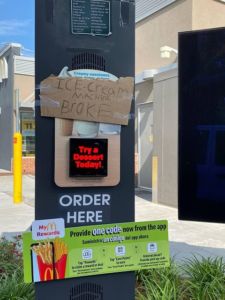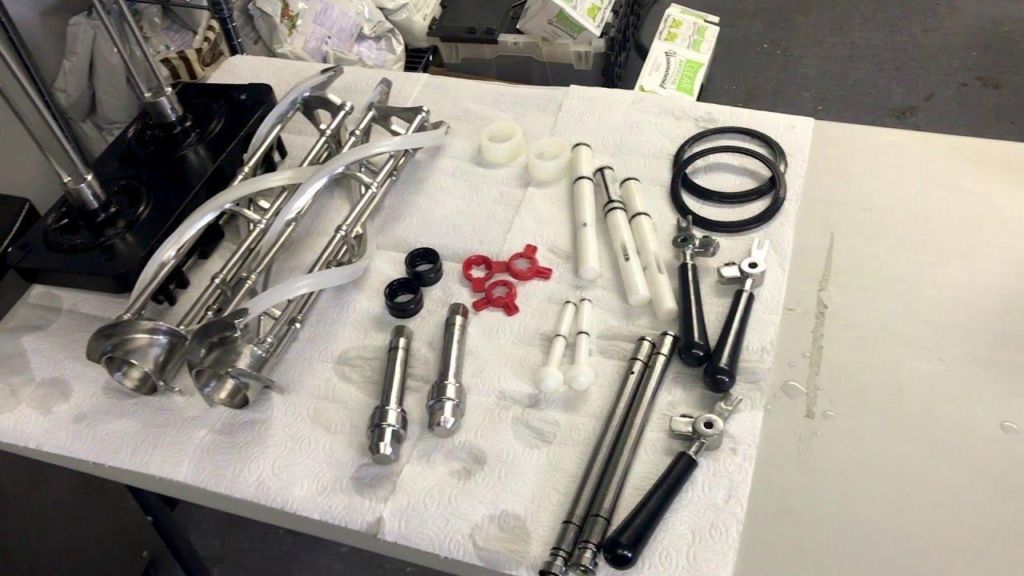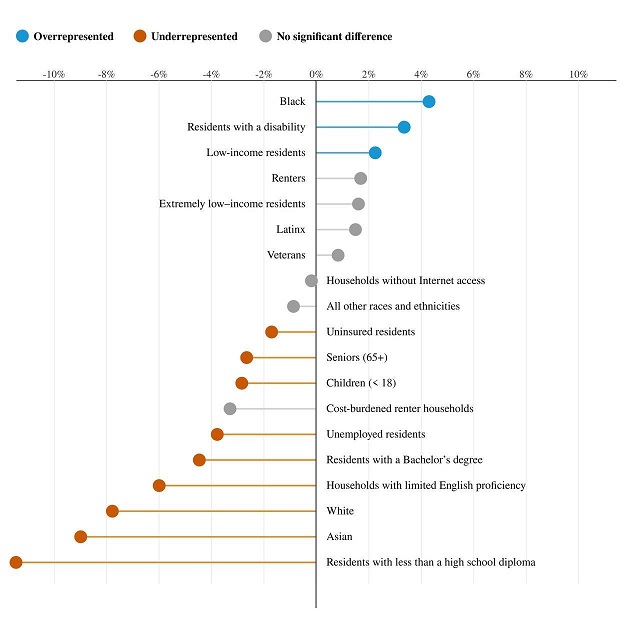Ice Cream Machines & Societal Disintegration
Posted By Richard Houck On In North American New Right | Comments DisabledLet’s talk ice cream machines. They’re a minor aspect of your daily life that you might not even notice much. Chick-fil-a, Shake Shack, McDonald’s, Wendy’s, In-N-Out, Steak ‘n Shake, Dairy Queen, Rally’s — they all have them. Your local family-owned and regional chain restaurants have them as well. They are everywhere, and I contend we can look at the ice cream machine as a miniature social-capital and livability data-outpost because of their ubiquity. We can get to know a particular store or area of town by its ice cream machine functionality level.
Unlike a grill, fryer, or freezer, there are many more moving parts in an ice cream machine. They also have more arduous cleaning routines that involve removing a handful of parts. Cleaning a grill, by contrast, requires no parts to be removed, cleaned, and replaced. In an ice cream machine, the mixers and several pans must be removed and cleaned, and sanitizing solutions and water must be run through the system.
When you order ice cream, you don’t want to hear “We’re out” or “It’s broken,” yet it has been happening so often across the United States in recent years that it became somewhat of a cultural meme that spawned considerable media interest. Reports indicate that up to a quarter of McDonald’s ice cream machines are not operational at any given time.
Ice cream sales make up 3% of total McDonald’s sales (over $22 billion annually), amounting to about a quarter of a billion dollars a year. If the company is losing out on roughly 25% of that, we have a $56 million question on our hands every year.[1] [3]
Media outlets looking to cover the story and capitalize on the “McBroken” meme published dozens of quite lousy pieces concluding that the extensive cleaning process and heat sanitization cycle are to blame for the machine’s maladies. I never bought that story for a few reasons. One thing that doesn’t add up with the “cleaning” explanation is why any restaurant would clean a machine while it is open, and how it could be true that ten to 25% of all working hours in them are dedicated to “cleaning.” Perhaps nobody wants to clean the machines, so they merely say that it is not working.
Next was to blame the machines themselves. Articles including employee testimonials described the “difficult” cleaning process. Another article blamed the pasteurization process, which can last several hours, but that is generally done overnight. These articles didn’t seem to even be trying to uncover the truth. In that, there is a meta-story about the journalism industry.
Then, in April 2021, a YouTuber named Johnny Harris uploaded a now-viral video with over nine million views titled, “The REAL Reason McDonald’s Ice Cream Machines Are Always Broken [4].” In this 30-minute exposé, Harris elaborates a new theory that has gained acceptance as the actual reason for the McDonald’s ice cream downtime. Harris explains that the manufacturer of the ice cream machines, Taylor, is to blame. Taylor is the industry standard and the same company that makes ice cream machines for most quick-service restaurants, and has been supplying the equipment to McDonald’s since 1956. The next time you see an ice cream machine, look for the manufacturer’s name. It’s probably a Taylor.
Harris posits that Taylor has made the machines intentionally onerous to operate so they can generate future revenue out of repair contracts. The theory is that Taylor deliberately makes ice cream machines that are always in need of service and are generally too complicated for restaurant workers to understand. Hence, they call Taylor’s service technicians, which keeps the company flush with cash flow. It’s an interesting theory, and the video hams it up. There are plenty of suspenseful cuts, long stares into the camera, and moments when you are supposed to be in shock as facts are uncovered, such as the long working history between McDonald’s and Taylor. Harris wants you to believe that corporate greed on Taylor’s end is to blame. In a way, Harris created the perfect scapegoat: shifting the blame from restaurant workers to shadowy business practices. People loved it, too. And it is entirely wrong.
Wired ran a similar story, blaming Taylor and including a discussion of a third-party ice cream machine diagnostic tool.[2] [5] The theory was again that Taylor wanted the machines to break down often in order to make money on the repairs. A company called Kytch makes a device that attaches to the Taylor machines and gives clear readouts of potential maintenance issues, such as if a pasteurization cycle has failed because the bins were overfilled with ice cream mixture. Taylor and McDonald’s asked franchisees not to buy the Kytch products because they were not authorized, had not been studied, and had no formal relationship with McDonald’s. Both Wired and Harris attempted to weave their conspiracy theory by presenting routine practices such as disallowing a franchisee from using unauthorized products or equipment into a story about shadowy corporate espionage and greed.
 [6]
[6]You can buy Greg Johnson’s The Year America Died here. [7]
There are some holes in this story as well. For one, if McDonald’s was sold a product by Taylor that is only operational 75% of the time, there is no way they would continue their contract with Taylor. There is also very little chance that Taylor would not be in a serious breach of their contract to begin with if they sold McDonald’s equipment that is defective 25% of the time without prompt remediation. I simply do not believe McDonald’s would willingly forgo nearly $60 million a year in sales, year after year, over a contract issue, as Harris and Wired want us to believe. Losses of that kind are unconscionable if a third-party vendor is to blame. McDonald’s simply would not allow this to continue.
I came across a couple of fascinating bits of information nobody else has mentioned in their discussion of this mystery.
Of all the outlets to cover the story, none of them got close to what I found, including The Wall Street Journal, Business Insider, Mashed, Boston Globe, Wired, and Inc. Vice News almost got there; they had the proper dataset to solve the mystery, but they fumbled, as expected.
First, I had to dig back a couple of years to find an article I remembered seeing which confirmed something we already know: restaurants owned by blacks, in black areas, do not perform as well as those in “less diverse” communities. McDonald’s has over 200 black franchisees out of the 1,700 or so owners — enough to make the data statistically reliable. Stores that the black franchisees own an average of $68,000 net less per month than all franchise stores. That’s $816,000 per year, per store, lower than the chain’s average.[3] [8]
There are probably many reasons for this disparity. Some black franchise owners postulated that a lack of black leadership in the McDonald’s corporation is an issue. I’m not sure there is a connection. Another issue raised was that black owners tend to own stores in black neighborhoods, where costs are high and sales are lower. There is a notion that nebulous socioeconomic issues tied to things like “white privilege,” “white supremacy,” and “systemic racism” are to blame: i.e., blacks have less money as a whole to spend on fast food, therefore making the sales of black-owned McDonald’s restaurants lower. To the extent that socioeconomic forces are genuine and legitimate, I will say the issue is not systemic racism or white people, but sub-Saharan genetics.
One of the black franchisees was interviewed about his experience. He said “my stores are hellholes,” and lamented that they are robbed once or twice per month. His further comments revealed that his stores are often vandalized: people destroy the bathrooms and break the windows, and a murder had even taken place on the premises of one restaurant.
The murder in the McDonald’s reminded me of a grocery store in Atlanta called “Murder Kroger.” The Ponce de Leon Avenue Kroger earned that nickname by being the stage for many violent crimes.[4] [9] Some Kroger stores actually left black neighborhoods not far from where I live because their outlets there were the worst in the company, suffering from extreme shoplifting and security issues. After pulling out of these neighborhoods, the company was declared “racist” and blamed for contributing to “food deserts” in black communities.[5] [10] The stores were simply not profitable and not worth the headache to keep open. Although some argue there is a white supremacist conspiracy theory keeping blacks from having nice grocery stores in their neighborhoods, the black community itself runs them out of business through their behavior. As states and cities continue to decriminalize shoplifting, this trend will continue.
 [11]Manhattan’s new black District Attorney declared that many “low-level offenses” would no longer be pursued. This policy, once known to petty criminals, has had the expected effect, which I saw first-hand on a trip to the city right before Christmas last year. I watched from a Manhattan pizza shop window as a black man walked out of a Rite Aid with a duffle bag filled with batteries and alcohol that he had clearly stolen. He strolled across the street, came into the pizza shop, and began offering bottles of wine and packs of batteries to customers and employees alike for the price of anything they were willing to pay. A month later, I see an article in the New York Post about Rite Aid stores closing due to theft, with one store losing $200,000 in merchandise in two months.[6] [12] Those who picked up prescriptions and other necessities at these outlets will have to travel somewhere else, further away, for their needs, the result of the policies and behaviors of the black population alone.
[11]Manhattan’s new black District Attorney declared that many “low-level offenses” would no longer be pursued. This policy, once known to petty criminals, has had the expected effect, which I saw first-hand on a trip to the city right before Christmas last year. I watched from a Manhattan pizza shop window as a black man walked out of a Rite Aid with a duffle bag filled with batteries and alcohol that he had clearly stolen. He strolled across the street, came into the pizza shop, and began offering bottles of wine and packs of batteries to customers and employees alike for the price of anything they were willing to pay. A month later, I see an article in the New York Post about Rite Aid stores closing due to theft, with one store losing $200,000 in merchandise in two months.[6] [12] Those who picked up prescriptions and other necessities at these outlets will have to travel somewhere else, further away, for their needs, the result of the policies and behaviors of the black population alone.
Another black McDonald’s franchisee said that his stores were among the worst in the company. They have low cash flows, serious staffing problems, and are often robbed. The black owners often blame McDonald’s corporate. Still, they did not seem to realize that their real gripe is with their own community and the behavior of their racial cohort. Part of the extra costs that the black franchises have to pay are for security, high insurance premiums, and constant repairs.
I interviewed a McDonald’s employee who works in a very “diverse” restaurant. He confirmed some of my theories and observations and added great additional insights. He mentioned that the restaurant where he works often has to repair bullet holes resulting from drive-by shootings in the street where they are located. Sure, racism could be blamed for the lack of sales in black stores in black neighborhoods, but one might also suggest that many people don’t want to put their lives at risk for a McFlurry or Big Mac.
Speaking of the elusive McFlurry, my interviewee said the ice cream machine in his restaurant is not ever actually broken. There are occasions when employees put the wrong mix into the machine, causing it to stop working until it is cleaned out and replaced with the correct mix. Few people at their store know how the pasteurization cycle works overnight, leading to some confusion about its operational status, and even fewer know how to clean the machine. In short, operator error is the culprit.
The next piece of evidence supporting my theory came from an article from October 2020 that circulated quite widely.Vice News reported that when a cross-analysis was performed utilizing an API tracker of broken McDonald’s ice cream machines along with a demographic analysis of the neighborhoods where they are located, they find a statistical overrepresentation of broken machines in black, Latinx, and low-income communities.[7] [13] In non-white communities, the machines are not functional in some places at a rate of double or more the national average, and at least three times the rate of white communities.
Further evidence discrediting the mainstream explanations — and the conspiracy theory about Taylor’s maintenance scheme — came from a founder of an equipment repair company that maintains ice cream machines for McDonald’s. Daniel Estrada of 86 Repairs says that of the thousand or so locations his company services, the Taylor ice cream machines average only two repair calls individually per year.[8] [15] Now we have testimony from a person in the repair industry telling us that it is rare for the machines to need professional servicing. If each repair is completed the same day or the next day, or even within a week, which is standard for commercial maintenance, that leads to a total of 4 to 7 down days per year, being generous. The machines should be operational on the other 358-361 days of the year.
With that information in mind, and knowing that demographics affects the rate of “broken” ice cream machines, we can draw further conclusions.
Ice cream machines do not know they are in black and Hispanic neighborhoods. Thus, we can probably rule out the existence of “racist ice cream machines” that make a conscious decision to stop working so they can deprive black and Latinx communities of ice cream.
Here is where we intersect with the meta-story about journalism. The objective of journalism is no longer to inform the public, but to weave a story of their choosing into a larger tapestry. Here, we see that the mainstream media was not willing or capable of telling the full story. Millions of people reading and watching the dozens of articles and videos on the matter have been led to believe in a conspiracy theory about ice cream machines and corporate greed, when the reality — and much more plausible tale — is one of basic biological differences between groups of people.
Further, it’s possible, and perhaps even likely, that the current mainstream journalist class is made up of people entirely incapable of uncovering deeper truths and unwilling to process any information that might contradict a larger societal theme. Much like the black franchisees, I’m sure they found a way to blame anybody but those actually responsible.
As is the case with everything else in my “social capital anthology,” this isn’t an article about broken ice cream machines. This is about what happens to a society when even the base level of social functionality — the bare minimum standard required to have something that looks like a real society — cannot be met.
Sure, you might argue that it’s better that the ice cream machines are breaking down, especially given that fast-food places are staffed by people you’d rather avoid anyway, is a good thing. You don’t need the empty calories and processed food with low nutrient density, anyway. Negative experiences at such places might even prompt you to cook at home more and save some money while you’re at it. I’m sure that’s probably true, but you’d be missing the point entirely.
This was never about the movies or the food or the mall or the corner store. It was about the social interactions and capital we once had as a society. It is about watching the functionality and livability of society slowly slipping away. Nobody is concerned only with the film, ice cream, or video game. There was a time when you could be out with people you cared about and enjoy their company in a functioning society without suffering the indignity of being around liberals who need to be institutionalized, or at the very least stripped of their rights, and non-whites whose mere existence among us is a form of terrorism that leads to the total deterioration of every aspect of society.
 [16]
[16]You can buy Greg Johnson’s Truth, Justice, & a Nice White Country here [17]
At some point along this trajectory, there will no longer be any upside rationalizations to be found. There will come a time when the people who cannot run the ice cream machine are not doing you a favor by making you choose better food options. There will come a time when the people who cannot run the ice cream machine are running things of a much greater importance. What will society look like when the person who is today a McDonald’s Assistant Manager who can’t or won’t ensure that the fries are hot is tasked with staffing air control towers or repairing bridges and roads? What happens when the worker who decided it “wasn’t his job” to clean the ice cream machine feels the same way about inspecting the brakes on your car? What happens when you very much need something to be done correctly, but everybody at the department in charge of whatever you need are those people who could barely keep an ice cream machine running for a full day?
How does that society look?
Part of my concern with importing so many denizens of the Global South is that they are accustomed to and seem to accept — even embrace — conditions we would find intolerable. Not only will they lower the standard of living by their very existence, but they also won’t mind all that much. It will likely still be better than from wherever they hail from. Their quality of life will improve even if ice cream machines are only operational 50% of the time; the same is true of bridges and everything else. As for us? Nobody will care, for one. We will appear to them as demanding and privileged. Wanting something to work well, to be in the proper order, and delivered on time is a trait unique to only a handful of people. When you think about it, only a handful of nations have been able to ensure that the trains run on time. An exceedingly small percent of the global population is capable of such a feat. And it’s okay to want the trains to run on time; that doesn’t make you a bad person.
After traipsing through well over a dozen articles and a video on the subject, as well as my testimonial, my conclusions are as follows. The ice cream machines are rarely ever really broken — maybe once or twice a year. The demographics of the store’s ownership, management, and employees is a more telling indicator of whether or not the ice cream machine functions than any other data point. Commercial restaurant equipment is designed and built to be bulletproof. I’ve been in restaurants with near-ancient equipment that was still functioning well.
Black and Latinx communities do not have higher levels of “broken” ice cream machines because the machines are racist. It’s because the staff in those restaurants are black and Latinx. The employees in such places are either too lazy, too uninterested, or too unintelligent to keep the ice cream machine up and running, which is truthfully a more complicated piece of equipment than anything else in the restaurant — perhaps a bit too complicated or too much work for the minds of diversity-Americans.
One of my McDonald’s sources provided some more in-depth insights. He said that at his restaurant, only the manager knows how to clean the ice cream machine and is the only one who does it. If that is also true of the other restaurants, then if the manager is too lazy to clean the machine, it might not get done at all — leading to failure.
There is opportunity for operator error, of course. In my source’s store, an employee often uses the wrong mixture in the ice cream machine, causing it to cease working. The heat cycle also often fails if the correct mixture is overfilled in the bins.
One of the many paradoxes of blacks in society is that if they do nothing but sit at home and collect welfare, they are a considerable burden upon the white taxpayer. If they have jobs, we have to deal with everything that comes with their employment. If you’re the end-user or a customer dealing with them, it means ice cream machines that do not function and overall difficulty completing the most basic requirements of their jobs.
In other restaurants I have personally observed an employee being told to clean the machine after the manager has left for the day, resulting in the employee being unable to put the machine back together after taking it apart for cleaning.
 [18]If you’ve noticed or kept track, as the staff becomes more diverse, the odds that something will go wrong with your order trends upward. Furthermore, as the staff of the local fast-food places becomes more diverse, the odds of everything in your community going wrong trends upward.
[18]If you’ve noticed or kept track, as the staff becomes more diverse, the odds that something will go wrong with your order trends upward. Furthermore, as the staff of the local fast-food places becomes more diverse, the odds of everything in your community going wrong trends upward.
If you’re looking for a house and want to know if it’s a “good neighborhood,” go to the local fast-food places and see if the ice cream machine is working or not and who is staffing the restaurants. If they can’t keep the ice cream machine running, they won’t be able to keep the schools nice or the property values up, either. It’s an early tell-tale sign of decay.
It is my belief that even fast-food spots and corner stores can not only be wholesome and nice gathering spots for younger people and those with little means, but that they can be signals of high trust and cultural development in a homogeneous nation.
I hope that one day, all the ice cream machines in your town are fully functional and operated by people who look like you. If that happens, you’ll know you made it. This might not seem like much to you right now, but one day you’ll understand how much it truly means.
And with that, I’ll leave you with a video a friend of mine shared from an ice cream shop where he grew up. It was called Ice Cream Town, and this is what it looked like while it was being run only by white high school kids in a small New England town in the late 1980s.[9] [19]

* * *
Counter-Currents has extended special privileges to those who donate $120 or more per year.
- First, donor comments will appear immediately instead of waiting in a moderation queue. (People who abuse this privilege will lose it.)
- Second, donors will have immediate access to all Counter-Currents posts. Non-donors will find that one post a day, five posts a week will be behind a “paywall” and will be available to the general public after 30 days.
To get full access to all content behind the paywall, sign up here:
Paywall Gift Subscriptions
 [20]If you are already behind the paywall and want to share the benefits, Counter-Currents also offers paywall gift subscriptions. We need just five things from you:
[20]If you are already behind the paywall and want to share the benefits, Counter-Currents also offers paywall gift subscriptions. We need just five things from you:
- your payment
- the recipient’s name
- the recipient’s email address
- your name
- your email address
To register, just fill out this form and we will walk you through the payment and registration process. There are a number of different payment options.
Notes
[1] [21] Julie Jargon. “Why Is the McFlurry Machine Down Again?” The Wall Street Journal. January 19, 2017.
https://www.wsj.com/articles/six-horrifying-words-the-mcflurry-machine-is-down-again-1484840520 [22]
[https://archive.ph/KJC59]
Hayley Peterson and Kate Taylor. “Why McDonald’s ice cream machines are seemingly always broken.” Business Insider. November 7, 2017.
https://www.businessinsider.com/mcdonalds-ice-cream-machine-always-broken-2017-8 [23]
[https://archive.ph/eWWMB]
Joel Stice. “The Real Reason McDonald’s Ice Cream Machines Always Seem To Be Broken.” Mashed. October 10, 2018.
https://www.mashed.com/135144/the-real-reason-mcdonalds-ice-cream-machines-always-seem-to-be-broken/ [24]
[https://archive.ph/uad9B]
Anissa Gardizy. “What’s going on with the McDonald’s ice cream machines?” Boston Globe. September 2, 2021.
[https://archive.ph/M2fg1]
Erin Snodgrass. “The FTC is investigating a very important question: Why are McDonald’s McFlurry machines always broken?” September 2, 2021.
[https://archive.ph/W1Kpq]
Ronnie Koenig. “Even the feds reportedly want to know why McDonald’s ice cream machines are always broken.” Today. September 2, 2021.
[https://archive.md/1c7hJ]
Kelly Main. “Why $4.7 Billion in Profits Won’t Fix McDonald’s Ice Cream Machines.” Inc. September 9, 2021.
https://www.inc.com/kelly-main/why-47-billion-in-profits-wont-fix-mcdonalds-ice-cream-machines.html [28]
[https://archive.ph/x6MBd]
Carly Stern. “Enough to make anyone scream!” Daily Mail. February 17, 2021.
[https://archive.md/YkMsf]
[2] [30] Andy Greenberg. “They Hacked McDonald’s Ice Cream Machines – and Started a Cold War.” April 20, 2021.
https://www.wired.com/story/they-hacked-mcdonalds-ice-cream-makers-started-cold-war/ [31]
[https://archive.ph/VS5mk]
[3] [32] Kate Taylor. “McDonald’s black franchisees are fighting to earn as much as their white counterparts, as dozens leave the company they once considered family.” December 9, 2019.
[https://archive.ph/kTzJE]
[4] [34] Kimberly Turner. “How ‘Murder Kroger’ got its nickname and why it won’t change.” Curbed Atlanta. April 11, 2017. https://atlanta.curbed.com/2014/8/15/10060010/murder-kroger [35] [https://archive.fo/1KKPO]
[5] [36] Alexander Coolidge and Sharon Coolidge. “Jesse Jackson calls to expand Kroger boycott over its shuttering of stores in minority neighborhoods.” USA Today. April 10, 2018. https://www.usatoday.com/story/money/nation-now/2018/04/10/jesse-jackson-kroger-protest/502688002/ [37] [https://archive.fo/mtvf3]
[6] [38] Nicole Gelinas. “Shoplifting kills a Rite Aid – and maybe Manhattan’s comeback chances.” January 30, 2022. New York Post. https://nypost.com/2022/01/30/shoplifting-kills-a-rite-aid-and-maybe-manhattans-comeback-chances/ [39] [https://archive.ph/8fjeF]
[7] [40] Edward Ongweso Jr. “A Bot Tracking McDonald’s Ice Cream Finds Troubling Racial Disparities.” Motherboard. October 26, 2020.
[https://archive.md/R8Mrw]
[8] [42] Katherine Peach. “Here’s How Often The Ice Cream Machines At McDonald’s Really Break – Exclusive.” Mashed. October 1, 2021. https://www.mashed.com/620758/heres-how-often-the-ice-cream-machines-at-mcdonalds-really-break-exclusive/ [43] [https://archive.is/eJ3a9]
[9] [44] Lloydel Pictures (373 subscribers as of December 20, 2021). “Ice Cream Town – 1989” YouTube. Uploaded: October 22, 2017.
https://www.youtube.com/watch?v=l-UzJhPjoxc [45]
This video was filmed at a local ice cream shop called Ice Cream Town in Hanover, Massachusetts in 1989. It was a popular hangout for high school kids, and this video is a fairly good representation of what it might have looked like on a typical night. The owner of the business took a very hands-off approach and became increasingly so as the months wore on. Eventually, she seemed to disappear entirely. Employees were showing up to work but weren’t getting paid any longer. The food and supplies were all running low, and eventually all that was left was a bucket of pistachio ice cream. Customers would come in to buy an ice cream and the kid on duty would be like, “We have one flavor. Would you like a small or a large?” This video was shot before things got that bad, but it wasn’t very long after it when things started to go downhill. At any rate, it’s a nostalgic look at 1989. Enjoy! Ice Cream Town filmed in the spring of 1989.


